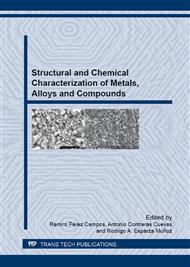[1]
A.K. Chaubey, S. Scudino, K.G. Prashanth, M. Stoica, G. Vaughan, N.K. Mukhopadhyay, B.K. Mishra, J. Eckert, Phase transitions in Al3Ca8 and Al14Ca13 intermetallic compounds induced by milling and annealing, Materials Letters 79 (2012) 145-147.
DOI: 10.1016/j.matlet.2012.04.026
Google Scholar
[2]
K.H. Tan, M.R. Johan, R. Ahmad, N.A. Kadri, N.M. Zain and A.K. Arof, Mechanical analysis of the effects of different mechanical alloying periods on Ni3Al intermetallic compound fabrication quality, Int. Journal Electrochemical Science 7 (2012).
Google Scholar
[3]
S. Shukla, A. Banas, R.V. Ramanujan, Atomistic mechanism of cyclic phase transitions in Nd–Fe–B based intermetallics, Intermetallics 19 (2011) 1265-1273.
DOI: 10.1016/j.intermet.2011.04.006
Google Scholar
[4]
M. Sherif EL-Eskandarany and A. Inoue, Mechanically induced cyclic metastable phase transformations of Zr2Ni alloys, Physical Review B 75 (2007), 224109.
Google Scholar
[5]
H. Shi, D. Guo, Y. Ouyang, Structural evolution of mechanically alloyed nanocrystalline FeAl intermetallics, Journal of Alloys and Compounds 455 (2008) 207-209.
DOI: 10.1016/j.jallcom.2007.01.079
Google Scholar
[6]
M. Krasnowski and T. Kulik, Amorphisation Process during mechanical alloying of Al-Fe-Ti powders and crystallisation of the milling products, Rev. Adv. Mater. Sci 18 (2008) 393-397.
Google Scholar
[7]
M. Seiersten, COST 507, Thermochemical database for light metal alloys, Vol. 2, (Ed. ) I. Ansara, A.T. Dinsdale, M.H. Rand, (1998).
Google Scholar
[8]
S. Kobayashi and T. Yakou, Control of intermetallic compound layers at interface between steel and aluminum by diffusion-treatment, Materials Science and Engineering A 338 (2002) 44-53.
DOI: 10.1016/s0921-5093(02)00053-9
Google Scholar
[9]
W.M. Tang, Z.X. Zheng, H.J. Tang, R. Ren and Y.C. Wu, Structural evolution and grain growth kinetics of the Fe–28Al elemental powder during mechanical alloying and annealing, Intermetallics 15 (2007) 1020-1026.
DOI: 10.1016/j.intermet.2006.12.005
Google Scholar
[10]
V. Sebastian, O.P. Suwalka, N. Lakshmi and K. Venugopalan, Ferromagnetism at room temperature in ball-milled Al-1at. %Fe, Indian Journal of Pure and Applied Physics 45 (2007) 839-841.
Google Scholar
[11]
J. Rodríguez-Carvajal, Fullprof (2011) (http: /www. ill. eu/sites/fullprof/).
Google Scholar
[12]
V. Rajkovic, D. Bozic and A. Devecerski, The properties of high-energy milled pre-alloyed copper powders containing 1 wt. %Al, J. Serb. Chem. Soc. 72 (2007) 45-53.
DOI: 10.2298/jsc0701045r
Google Scholar


